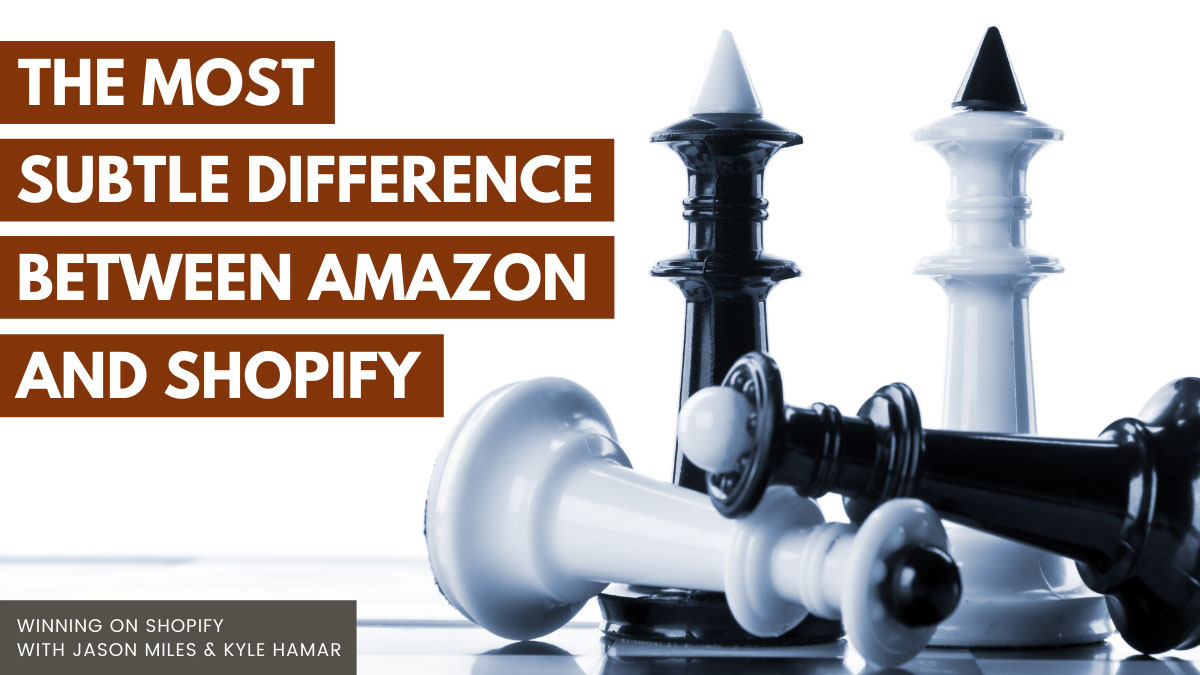The Little Known Differences Between Amazon And Shopify That Radically Change Your Income

I'll never forget the day I was sitting in a room of over 500 online sellers (the vast majority were selling on Amazon) and the speaker asked everyone selling over $5,000 per month online to stand up. Half the room stood up, including me.
- She asked people to remain standing if they sold over $10,000 a month. A good number of people sat down.
- She asked people to remain standing if they sold over $20,000 a month. More sat down.
- She asked people to remain standing if they sold over $30,000 a month. At that point there were about 20 people standing.
- She asked people to remain standing if they sold over $40,000 a month. Most of them sat down.
- She asked people to remain standing if they sold over $50,000 a month. Two people were standing - me and Mike Brown of Death Wish Coffee.
- She thanked everyone for sharing their results, asked the audience to applaud us, and asked us to sit down.
I was shocked. First of all, where did all the amazing Amazon sellers go? Why did they drop out so early? Second, what do Mike Brown and I have in common? (I knew the answer - we both primarily sell direct to consumers on Shopify).

Amazon's Amazing Attributes
That group exercise really got me thinking - I still flash back to it regularly. Not because it made me feel proud (or affirmed) but because it made me evaluate the pros and cons of Amazon vs. Shopify - and the differences in the two systems. I've come to realize that it is those differences that make a radical change to your sales results and income.
Of course - many 3rd party Amazon sellers have found an amazing path to personal profit. It's provided real income - in a work from home arrangement. There is no lack of love for Amazon on my part - people's Amazon selling results are real - and they should be excited about them.
Although we didn't start on Amazon - we started our online business in February 2008, as an eBay store. Our goal was $1,000 a month. Since then we've sold our products on Amazon, Etsy, Zulilly, Kajabi, Kindle, and on our own Wordpress site(s).
Fast forward to November 2016 (almost 9 years after we started) and we sold $77,000 worth of products on one of our Shopify sites. Our goal for 2017 is $70,000 a month. (Note - this is a gross sales figure, not personal income).
So what are the primary differences between Amazon (and eBay) and Shopify? Let's break it down...

Subtle Differences That Help You In The Short -Term & Limit Your Potential In The Long-Term
I've come to view some of the benefits of Amazon as also limiters to long-term success. So the thing that makes it easy in the short-term, shape your ultimate online potential over time. Here are a few examples...
Low-Functioning Brands: On a marketplace like Amazon, you can operate without what I call a "High Functioning Brand". Meaning you can sell things with almost no brand of your own, (for example by selling retail arbitrage items), or with a brand that doesn't really inspire anyone.
Of course, if you sell online - you have a brand, (get too many bad reviews against "your brand" and Amazon will kick you off. They don't kick off the products being sold - they kick off you as the seller).
Benefit or Limiter? While having a low-functioning brand eliminates a barrier to entry for people who want to sell online - it also creates an invisible ceiling (or financial limit) that will eventually slow business growth.
Now, in fairness, some people don't want to create a high functioning brand. It feels like too much work, or they don't have the long-term commitment to the product they are selling. That's fair.
Or, more commonly, they don't have a product that (they believe) can stand alone out in the real world of competitive marketing and be sold outside of the large marketplace with any degree of financial success. Maybe that's because they don't believe they have the skills to pull off a stand-alone website and associated marketing, or maybe it's because there is a large well-entrenched market leader that already owns the category that they feel they cannot compete against.
They may certainly be right in their analysis.
But for some sellers, who have a good product strategy that they believe has long-term competitive potential, it might be possible to creatively position the product (especially if it is a private label product) as a stand-alone, direct-to-consumer item via Shopify.
Little Or No Promotional Marketing: On a marketplace, you can sometimes get away with not doing (very much) promotion to raise awareness for your product offering and send targeted traffic to your listing. The marketplace can (and many times does) do a good job of generating buying traffic that you can benefit from without any additional marketing.
Benefit or Limiter? But the down side is that you never learn to do promotional marketing. Courses that teach you how to do (free or paid) promotional marketing in support of your Amazon listing are smart - especially if you can boost the sales velocity and reviews of a product you sell regularly - so the Amazon organic traffic ranks your items more highly because of your advertising.
Courses that teach you how to do (free or paid) promotional marketing in support of your Amazon listing can be a helpful idea - especially if you can boost the sales velocity and reviews of a product you sell regularly - so the Amazon organic traffic ranks your items more highly because of your advertising.
However, if you're going to learn to do promotional marketing - you'd be wise to consider the merits of creating a High-Functioning Brand - so that you can parlay the benefits of the advertising (time and money) into long-term customer loyalty, tribe building, and recurring sales.
Learning to do promotional advertising in support of a product you don't love (and don't have a long-term ongoing source for) is a recipe for disappointment.
Me-To Pricing Strategies: On a marketplace, you can get away with employing "me too" pricing and not work too hard to figure out a unique pricing strategy that benefits customers in a unique way and bonds them to your brand and product.
Benefit or Limiter? The downside is that if no one has any creative pricing strategy options (except lowering or raising prices) you can quickly get into a pricing war, which destroys any hope of income).

The Most Subtle Difference Between Amazon & Shopify
Amazon has a set of policies and rules designed to support the "vast majority" of their sellers. That means they are constantly optimizing their entire system for:
- Their average seller (so they can serve)
- Their average buyer
This is super important to understand because (like with any game with rules) the rules are what make the game.
Your game on Amazon is tied to following their rules - to get their prescribed outcome. Again, there is nothing wrong with this - but it will produce an "average" outcome for sellers. Sure, you can work harder, learn tricks, take special training, (and you should), but the game is built to produce a standard outcome.
As the 'stand up if you sell over' exercise demonstrated - that standard outcome is a relatively low sales volume number. Not because Amazon wants to hold you back (big aha moment coming up) but because the barriers to entry they removed for you so that you could sell on their system - are the very things that will hold you back from exceptional growth. Remember the old "Standard Distribution" charts from 9th grade math? It explains how Amazon, (or any marketplace owner) is going to think about creating policies and rules that define the outcome. They are going to design their system for no more than 2 standard deviations from the mean, (or put simply) design for a use-case that supports 95% of their participants.


What Makes Shopify Hard Also Makes It Powerful
The biggest difference between Amazon and Shopify is even more subtle. It's not about where you sell, it's about what you can actually successfully sell.
On Amazon you can sell almost anything (I know, there are gated categories and restricted items, but you get my general point).
On Shopify you can only sell (at scale for the long-term):
- In-demand products that customers want to come find on your site and buy from you versus the competition.
- Products you can source profitably with enough margin to...
- Promote via paid (and organic) advertising strategies.
- In support of a High Functioning Brand that attracts customers.
All these (apparent) barriers to selling on Shopify actually set the stage for out-sized sales and income results. It's like building a rocket - hard work - but when you have the functional rocket - things get exciting! Rocket ride time!
In other words, the things that make people feel like Shopify can't work for them - are the very things that make it work so well once those items are resolved.
Conclusion
I hope if you're selling on Amazon - and considering adding Shopify - this article has helped clarify some of the more subtle differences. Our current mentoring group program is closed to new participants, but if this article resonates with you - then consider joining us next time we open enrollment. We are passionate about mentoring and coach people as they work through these challenges.
If you'd like additional training and coaching to achieve your Shopify goals, consider applying for our coaching program today!
Jason Miles

